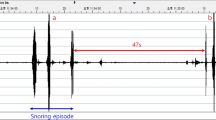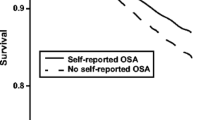Abstract
The formerly accepted view that snoring is, at worst, an annoying or irritating factor in human sleep can no longer be maintained in the light of recent medical evidence. Snoring has been discovered to be an important pathophysiological and pathogenic factor, particularly in two fields: sleep apnea (SA) syndromes and essential hypertension. For patients with SA, histories of many years or even decades of loud and irregular snoring have been described [1]. Habitual snoring must be evaluated as an early symptom of obstructive SA [2, 3].
Access this chapter
Tax calculation will be finalised at checkout
Purchases are for personal use only
Preview
Unable to display preview. Download preview PDF.
Similar content being viewed by others
References
Guilleminault C, van den Hoed J, Mitler MM (1978) Clinical overview of the sleep apnea syndromes. In: Guilleminault C, Dement WC (eds) Sleep apnea syndromes. Liss, New York, pp 1–12
Lugaresi E, Coccagna G, Farneti P, Mantovani M, Cirignotta F (1975) Snoring. Electroencephalogr Clin Neurophysiol 39:59–64
Lugaresi E, Coccagna G, Cirignotta F (1978) Snoring and its clinical implications. In: Guilleminault C, Dement WC (eds) Sleep apnea syndromes. Liss, New York, pp 221–224
Mondini S, Zucconi M, Cirignotta F, Aguglia U, Lenzi PL, Zault C, Lugaresi E (1983) Snoring as a risk factor for cardiac and circulatory problems: an epidemiological study. In: Guilleminault C, Lugaresi E (eds) Sleep/wake disorders. Raven, New York, pp 99–106
Jennum P, Schultz-Larsen K, Wildschiødtz G (1985) Snoring as a medical risk factor. I. Relation to arterial blood pressure, weight and use of antihypertensive medicine. Sleep Res 14:170
Lavie P (1983) Incidence of sleep apnea in a presumably healthy working population: a significant relationship with excessive daytime sleepiness. Sleep 6:312–318
Peter JH, Köhler U, Mayer J, Podszus T, Penzel T, v. Wichert P (1985) The prevalence of sleep apnea activity (SAA). Sleep Res 14:197
Peter JH (1985) Holter monitoring technique in a comprehensive approach: ambulatory monitoring of sleep apnea. In: Hombach V, Hilger HH (eds) Holter monitoring technique. Schattauer, Stuttgart, pp 127–149
Editor information
Editors and Affiliations
Rights and permissions
Copyright information
© 1987 Springer-Verlag Berlin Heidelberg
About this paper
Cite this paper
Zahorka, M. et al. (1987). Snoring, Sleep Apnea, and Hypertension in a Field Study. In: Peter, J.H., Podszus, T., von Wichert, P. (eds) Sleep Related Disorders and Internal Diseases. Springer, Berlin, Heidelberg. https://doi.org/10.1007/978-3-642-72560-9_24
Download citation
DOI: https://doi.org/10.1007/978-3-642-72560-9_24
Publisher Name: Springer, Berlin, Heidelberg
Print ISBN: 978-3-642-72562-3
Online ISBN: 978-3-642-72560-9
eBook Packages: Springer Book Archive




